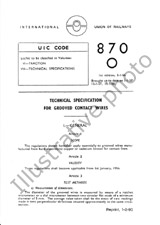We need your consent to use the individual data so that you can see information about your interests, among other things. Click "OK" to give your consent.

UIC B126/DT413-1ed.
Braking Problems - Feasibility study on the replacement of cast iron blocks with L blocks (additional block brake on coaches)
Translate name
STANDARD published on 1.5.2005
The information about the standard:
Designation standards: UIC B126/DT413-1ed.
Publication date standards: 1.5.2005
SKU: NS-1190162
The number of pages: 64
Approximate weight : 192 g (0.42 lbs)
Country: International technical standard
Category: Technical standards UIC
Annotation of standard text UIC B126/DT413-1ed. :
The avoidance of noise is an increasingly significant issue for all the railways in Europe. One of the chief ways of achieving this is to replace the cast iron brake blocks which presently predominate with composite products. For new-build wagons, this retrofitting process has already begun, whilst for existing wagons preparations are underway. Rolling noise can also be significantly reduced, however, on disc-braked coaches with an additional cast iron block brake, if the cast iron block is replaced by one made of composite materials. This feasibility study estimates the anticipated noise reduction and of the necessary preparations and accompanying measures. "+ "
Name:Fragen des Bremswesens. Machbarkeitstudie zum Ersatz der Graugusssohle durch eine LSohle bei der Zusatzklotzbremse von Reisezugwgen|"+ "
We recommend:
Technical standards updating
Do you want to make sure you use only the valid technical standards?
We can offer you a solution which will provide you a monthly overview concerning the updating of standards which you use.
Would you like to know more? Look at this page.



 Cookies
Cookies
